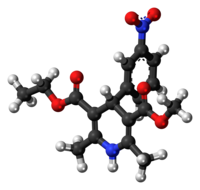Nitrendipine
 |
|
 |
|
| Clinical data | |
|---|---|
| Trade names | Baypress |
| AHFS/Drugs.com | International Drug Names |
| Routes of administration |
Oral |
| ATC code | |
| Pharmacokinetic data | |
| Bioavailability | 60–70% |
| Protein binding | 98% |
| Metabolism | Hepatic (completely) |
| Onset of action | 1–2 hours |
| Biological half-life | 8–24 hours |
| Excretion | Urine (30%) |
| Identifiers | |
|
|
| CAS Number | |
| PubChem CID | |
| IUPHAR/BPS | |
| DrugBank | |
| ChemSpider | |
| UNII | |
| KEGG | |
| ChEBI | |
| ChEMBL | |
| ECHA InfoCard | 100.049.540 |
| Chemical and physical data | |
| Formula | C18H20N2O6 |
| Molar mass | 360.361 g/mol |
| 3D model (Jmol) | |
| Chirality | Racemic mixture |
| Melting point | 158 °C (316 °F) |
|
|
|
|
|
|
|
Nitrendipine is a dihydropyridine calcium channel blocker. It is used in the treatment of primary (essential) hypertension to decrease blood pressure and can reduce the cardiotoxicity of cocaine.
Hypertension is the chronic condition where the blood pressure is elevated beyond normal levels that vary among individuals. The elevated levels in blood pressure increases the systemic vascular pressure, which increases the workload of the heart. The mechanical stress on the heart initiates a protein cascade involving G-proteins, cyclic-AMP and PKA that result in activation of genes that make cardiac muscle cells grow. The increased stress on the heart causes the heart to enlarge to accommodate the workload. However, the enlarged heart also needs structural support, which is why it produces scarring. The enlargement of the heart can make it hard for some cells to get nutrients because they are too distant from the blood vessels. Also, scarring can interfere with the electrical signals that cause the heart to contract and it also limits the ability of the heart to contract and relax. In both cases there is an increase risk of heart failure.
Nitrendipine is given to hypertensive individuals in 20 mg oral tablets every day. This amount is effective in reducing blood pressure by 15–20% within 1–2 hours of administration. With long-term treatments, the dosage may rise to as much as 40 mg/day; in elderly individuals, a lower dosage of up to 5 mg/day may be equally effective (this reduction in drug amount is attributed to decreased liver function or “first pass” metabolism). Once digested, nitrendipine is absorbed into the blood and binds to plasma proteins. The majority (98%) is bound to plasma proteins and 70-80% of its inactive polar metabolites are also bound to plasma proteins. Following hepatic metabolism, 80% of the 20 mg dose can be recovered in the first 96 hours as inactive polar metabolites. The specific volume of distribution of the drug is 2-6 L/kg. In terms of drug half-life, nitrendipine has a half-life of 12–24 hours. The reported side effects include: headache, flushing, edema and palpitations. These side effects can all be attributed to the vasodilation effect of this drug.
...
Wikipedia
